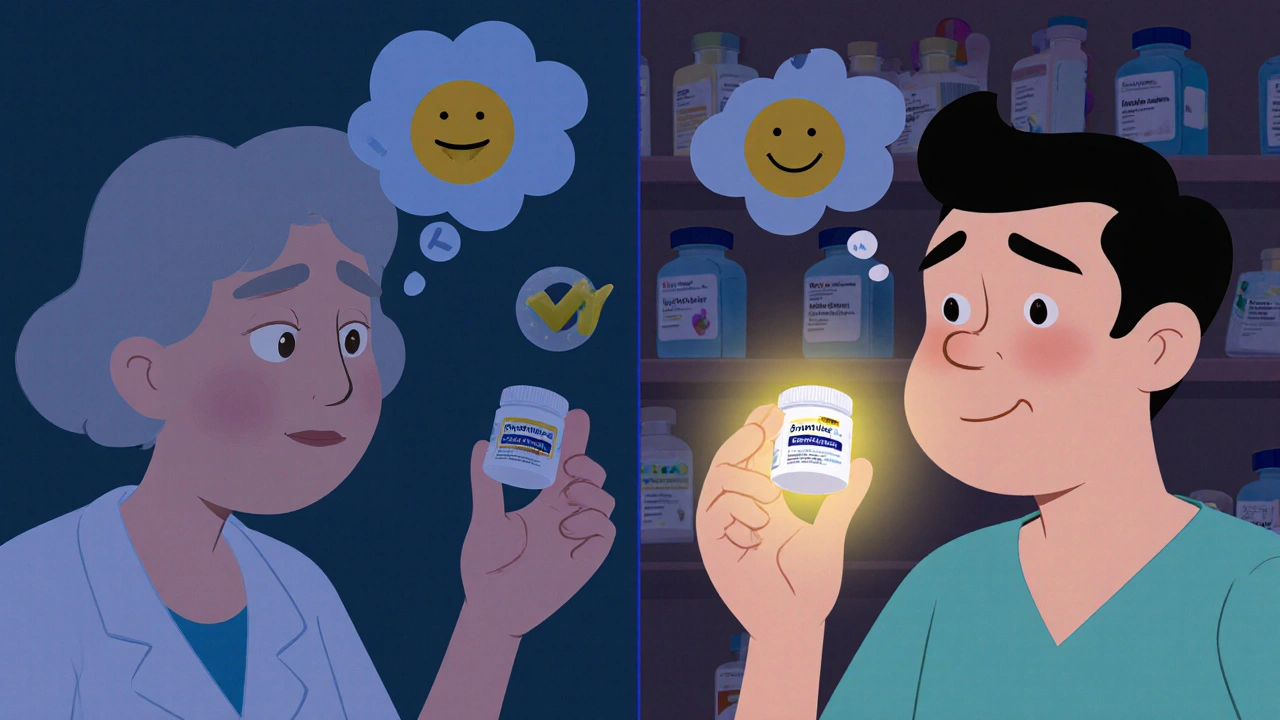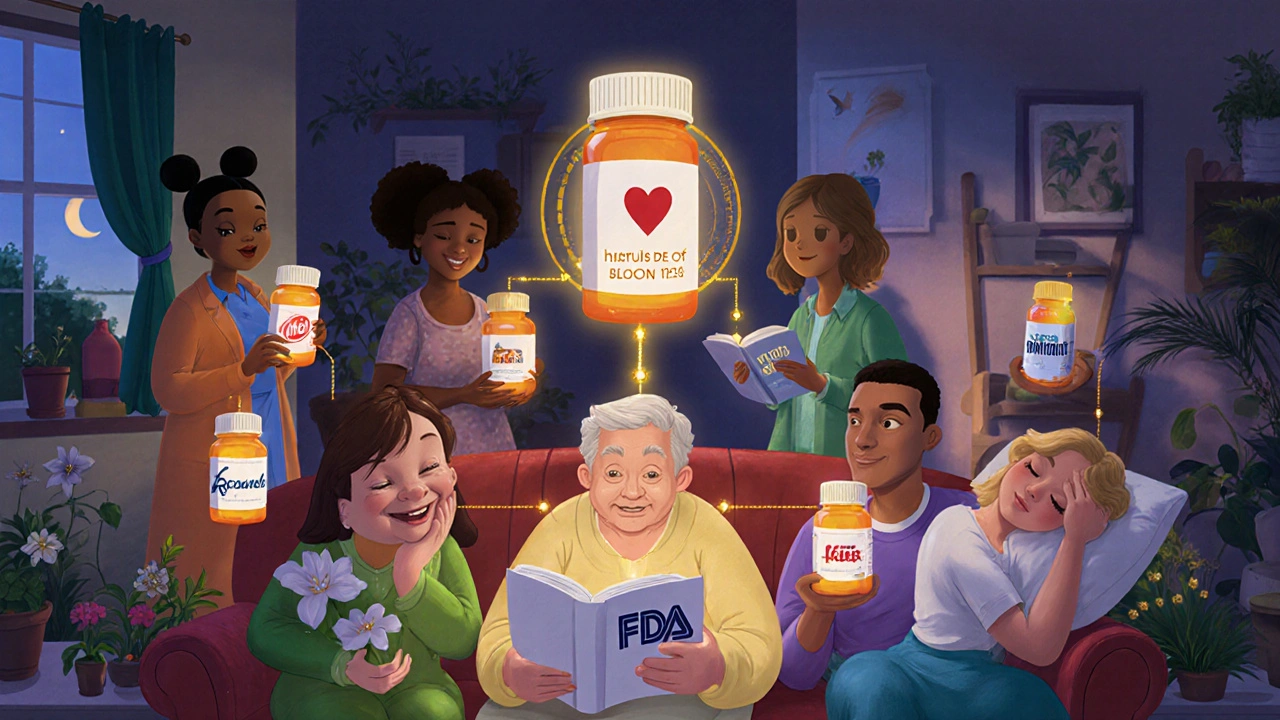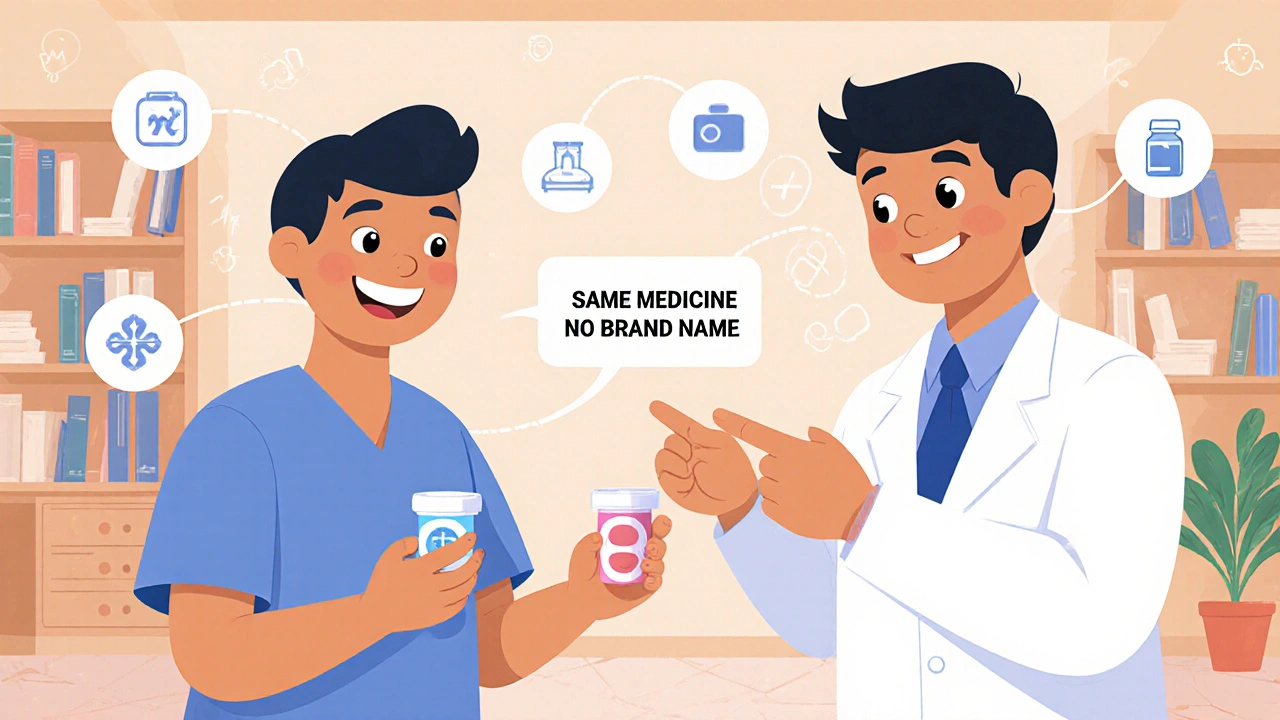When your doctor prescribes a brand-name drug and you get a cheaper version at the pharmacy, you might assume it’s just another generic. But what if that cheaper version was made by the same company that made the brand drug-same pills, same factory, same ingredients? That’s an authorized generic. And surprisingly, more patients choose it than you’d think.
What Exactly Is an Authorized Generic?
An authorized generic isn’t just similar to the brand-name drug-it’s the exact same drug. Same active ingredient. Same inactive ingredients. Same color, shape, and size. The only difference? No brand name on the label. It’s made by the original manufacturer under their own FDA-approved New Drug Application (NDA), not through the usual generic approval process. This matters because traditional generics must prove they’re "bioequivalent" to the brand. That means they work the same way in your body, but they can have different fillers, dyes, or coatings. Those small changes sometimes cause side effects or make patients feel like the drug doesn’t work as well. With authorized generics, there’s no guesswork. You’re getting the same product your doctor prescribed, just without the brand logo.Why Do Patients Prefer Authorized Generics?
A 2018 study tracking over 210,000 patients found something surprising: when people switched from a brand-name drug to an authorized generic, only 22.3% went back to the brand. That’s compared to 28.7% who switched back after trying a traditional generic. That’s a 22% drop in switchbacks. Why? Because patients don’t notice a difference. In a Consumer Reports survey of 1,200 people, 78% couldn’t tell the difference between an authorized generic and the brand-name version when given unlabeled pills. That’s way higher than the 52% who could spot the difference with regular generics. Reddit users on r/pharmacy echoed this. In a 2022 thread with 87 comments, 63% said they saw no difference between authorized generics and brand drugs. Many mentioned they’d been on the same medication for years and never noticed a change-until they switched to a traditional generic, which made them feel "off." For people with chronic conditions-like high blood pressure, depression, or epilepsy-consistency matters. A pill that looks and feels the same reduces anxiety. It’s not just about price. It’s about trust.But What About Price?
Price is still the biggest driver of choice. Authorized generics are cheaper than brand-name drugs-usually 15-30% less. But they’re not as cheap as traditional generics. When a brand drug loses patent protection, the first generic to enter the market gets 180 days of exclusivity. During that time, if the brand company launches an authorized generic, prices drop 4-8% at retail and 7-14% at wholesale. That’s a big win for consumers. But after those 180 days, traditional generics usually drop even lower-often 15-25% cheaper than authorized generics. That’s when patient behavior shifts. In the first six months, authorized generics capture 35-40% of the market. After that, traditional generics take over 65-75% because they’re simply cheaper. So patients don’t choose authorized generics because they’re the cheapest. They choose them because they’re the most familiar. But if the price gap widens, most will go for the lowest cost.
Who Decides What You Get?
Here’s the catch: most patients don’t actually choose. Insurance companies and pharmacy benefit managers (PBMs) control which drugs are dispensed. A 2022 KFF analysis found that 82% of commercial insurance plans automatically substitute generics-authorized or traditional-for brand-name drugs. Only 12% let patients or doctors request the brand without prior approval. That means even if you prefer an authorized generic, your pharmacy might give you a traditional one because it’s cheaper for the insurer. Pharmacists often don’t even know which version they’re handing out unless they check the FDA’s Orange Book or the "Products with No Applicant" list. Some patients learn to ask. "Is this the same as the brand?" is a smart question to ask at the counter. But most don’t. They trust the pharmacy. And if the pill looks different, they assume it’s just another generic.Why Do Drug Companies Use Authorized Generics?
It’s not just about helping patients. It’s business. Brand companies use authorized generics to protect their profits after patent expiration. By launching their own generic version, they capture market share before competitors even get started. The Federal Trade Commission found that when a brand company releases an authorized generic, it can cut competitors’ revenues by 30% during the first 180 days. Some critics say this is anti-competitive. The FTC has flagged cases where brand companies strike deals with generic makers: "We’ll let you be the first generic-if you promise not to launch until we’re ready with our own version." These "no-launch" agreements are under scrutiny. In 2021-2022, the FTC identified 23 such deals. If these become common, they could delay real competition and keep prices high longer. But for patients, the short-term benefit is real. Authorized generics bring down prices faster than waiting for traditional generics to enter. A 2022 Drug Patent Watch case study on entacapone showed Medicaid prices dropped 8.4-10.3% and on-invoice prices fell 13-18% when the authorized generic launched.
Are Authorized Generics Safe?
Yes. The FDA requires them to meet the same quality standards as the brand-name drug. They’re made in the same facility, using the same equipment and processes. There’s no extra review needed because they’re already approved under the original NDA. That’s why they’re trusted by pharmacists. Karen Berger, a staff pharmacist in Minnesota, told Managed Healthcare Executive that authorized generics give patients "a smoother transition" because they’re identical. She’s seen patients panic when their pill changes color or shape. With authorized generics, that rarely happens. The FDA even requires manufacturers to notify them when they launch an authorized generic. That’s not true for traditional generics. So there’s more oversight.What Does the Future Hold?
Authorized generics are growing. In 2010, they made up 15% of new generic entries. By 2022, that jumped to 30%. They now account for 12% of all generic drug units dispensed-up from 8% in 2015. Sales hit $8-10 billion annually in the U.S. The trend is likely to continue. Seven of the top ten pharmaceutical companies-including Pfizer, Merck, and AbbVie-have launched authorized generics. Cardiovascular and nervous system drugs lead the way. But there’s tension. The generic drug industry warns that authorized generics undermine the intent of the Hatch-Waxman Act, which was designed to speed up competition. The Congressional Budget Office predicts that if brand companies use them to delay full generic competition, Medicare Part D could pay $1.2 billion more by 2027. For patients, the future is mixed. You’ll likely see more authorized generics on shelves. But whether you get one depends less on your preference and more on what your insurer approves.What Should You Do?
If you’re switching from a brand-name drug to a generic, ask your pharmacist:- Is this an authorized generic?
- Is it made by the same company as the brand?
- Can I request it if it’s not the default option?
Are authorized generics as safe as brand-name drugs?
Yes. Authorized generics are made by the same company, in the same facility, using the same ingredients and processes as the brand-name drug. The FDA requires them to meet the same quality standards. There’s no difference in safety or effectiveness.
Why are authorized generics sometimes more expensive than regular generics?
Because they’re made by the original manufacturer, they don’t have the same cost-cutting pressures as traditional generics. Traditional generics are made by separate companies that compete aggressively on price. Authorized generics usually cost 15-25% more than traditional generics after the initial 180-day exclusivity period.
Can I ask my pharmacy for an authorized generic?
Yes, but it depends on your insurance. Most plans automatically pick the cheapest option. If you want an authorized generic, ask your pharmacist if it’s available and if your plan allows it. You may need your doctor to write "dispense as written" on the prescription to ensure you get it.
How do I know if a generic is authorized?
Check the FDA’s Orange Book or the "Products with No Applicant" list online. Authorized generics are listed under the brand’s NDA number with no separate applicant. Your pharmacist can also tell you-they often have access to this info. If the manufacturer name on the bottle matches the brand-name drug’s maker, it’s likely an authorized generic.
Do authorized generics work better for chronic conditions?
For many patients, yes. Studies show lower switchback rates for authorized generics compared to traditional ones, especially for conditions like epilepsy, depression, and high blood pressure. Patients report fewer side effects and more confidence because the pill looks and feels identical to what they were taking before.


Julie Pulvino
November 24, 2025 AT 11:07My grandma switched from her brand-name blood pressure med to an authorized generic and didn’t even notice-until her pharmacist told her. She said it felt like the same pill, just cheaper. Now she won’t take anything else. Trust matters more than we think.
Patrick Marsh
November 24, 2025 AT 13:27Authorized generics aren’t magic. They’re just the same drug with a different label.
Danny Nicholls
November 26, 2025 AT 08:13OMG YES 😍 I’ve been on the same antidepressant for 7 years and switched to the authorized generic last year-zero difference. My anxiety actually went down because I stopped worrying if it was ‘real’ or not. Pharmacies should just label them better 🙏
Ravi Kumar Gupta
November 26, 2025 AT 08:57In India, we don’t even have this luxury. Our generics are made in 50 different factories, each with different fillers. Some make you sleepy, some make you jittery. I wish we had authorized generics here-no one trusts our generics anymore. My uncle stopped taking his meds because he got a blue pill one month and a yellow one the next. He thought it was a scam.
Miruna Alexandru
November 27, 2025 AT 03:51The structural irony here is that the pharmaceutical industry, which has spent decades marketing brand-name drugs as uniquely superior, now leverages that very perception to sell a product that is, by definition, identical. The authorized generic is not a concession to patient trust-it is a monetization of it. The FDA’s regulatory framework, designed to ensure equivalence, has been co-opted into a market segmentation tool. Patients are not choosing authenticity; they are being steered toward a branded illusion that carries no branding. This is capitalism’s most elegant sleight of hand: selling sameness as a premium product, while the true generics-made by independent manufacturers-are systematically marginalized by insurance algorithms and PBM incentives. The patient wins in the short term, but the system wins in the long term-and it’s not even pretending to be altruistic anymore.
Rahul Kanakarajan
November 28, 2025 AT 13:01Why are people still surprised by this? Of course the brand company makes the cheapest version that still looks the same-of course they do. They’re not here to help you. They’re here to profit. If you’re still taking brand-name drugs because you think generics are ‘weaker,’ you’ve been scammed for years.
Robin Johnson
November 29, 2025 AT 22:08Great breakdown. One thing I’d add: if you’re on a chronic med and you notice a change-any change-don’t just assume it’s ‘all in your head.’ Ask for the authorized version. Your body remembers the pill. It’s not placebo. It’s pharmacology.
Daniel Jean-Baptiste
December 1, 2025 AT 03:18My pharmacist told me last week that my insulin generic was authorized-same maker as the brand. I didn’t even know that was a thing. Now I’m asking every time. Small things like this matter a lot when you’re managing a chronic condition. Thanks for making me aware.
luke young
December 1, 2025 AT 12:44Just asked my pharmacist today if my Zoloft was authorized. He said yes. I felt like I won the lottery. No side effects, same price as the other generic. Why isn’t this common knowledge?
Nikhil Chaurasia
December 1, 2025 AT 21:37My dad’s epilepsy med switched from authorized generic to regular generic last month. He had three seizures in two weeks. We switched back. The pill looked different. That’s all it took. Doctors don’t talk about this. Pharmacies don’t explain it. Patients suffer silently because they think it’s ‘all in their head.’ It’s not.